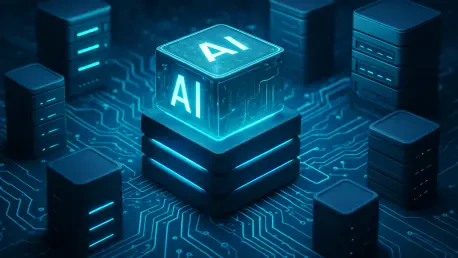In a world where technology evolves at breakneck speed, the current year stands as a defining moment for artificial intelligence (AI) and storage solutions, which are fundamentally transforming the industry with billions of dollars flowing into AI startups. Groundbreaking advancements in storage hardware and software address the insatiable demand for data processing and security. This surge is not just about innovation but also about building the infrastructure to support a digital future driven by intelligent systems. From hyperscaler data centers to cutting-edge flash memory, the tech ecosystem is buzzing with developments that promise to reshape how businesses and consumers interact with data. This article delves into the pivotal trends and breakthroughs that are steering the course of technology, exploring the deep connections between AI growth, storage evolution, cybersecurity challenges, and the collaborative efforts fueling this era of change. The focus remains on how these elements interweave to create a robust foundation for the next wave of digital transformation, highlighting the critical role of investment and innovation in overcoming modern challenges.
Fueling the Future with AI Investments
The scale of financial backing for AI companies this year is a clear indicator of the sector’s transformative potential, with valuations soaring into the hundreds of billions. Major players like Anthropic and Databricks have secured staggering funding rounds, reflecting a profound belief among investors that AI will underpin the next generation of technological progress. These investments are not merely speculative; they are strategic moves to capture market share in a field that promises to revolutionize everything from enterprise operations to consumer applications. The capital influx is driving research and development at an unprecedented pace, ensuring that AI tools become more sophisticated and accessible. Beyond the headline numbers, this financial momentum signals a broader shift in priorities, where data-intensive applications are seen as the cornerstone of future growth, necessitating robust support systems to handle their complexity and scale.
Complementing the focus on AI software, a significant portion of investment is directed toward the infrastructure required to power these technologies. Companies like Nscale, a UK-based hyperscaler, have raised hundreds of millions to build AI-ready data centers, supported by industry giants such as Nvidia and Dell. This rush to construct localized, high-performance facilities underscores a critical realization: AI’s success depends heavily on the availability of scalable computing and storage resources. These data centers are designed to meet the unique demands of AI workloads, ensuring low latency and high throughput for tasks like model training and real-time inference. The emphasis on sovereign infrastructure also reflects geopolitical considerations, as nations seek to maintain control over critical tech assets. This trend of infrastructure investment is creating a ripple effect, pushing advancements in hardware and energy efficiency to sustain the growing appetite for computational power.
Revolutionizing Storage for AI Demands
Storage technology is experiencing a rapid transformation to keep pace with the data requirements of AI applications, challenging long-held assumptions about performance and cost. Dell’s advocacy for Quad-Level Cell (QLC) flash technology exemplifies this shift, demonstrating that QLC can match the speed of more expensive alternatives while significantly reducing expenses for enterprise environments. With sub-millisecond latency, QLC is proving viable for transactional workloads, a development that broadens access to high-performance storage solutions. This innovation is particularly crucial as businesses grapple with the exponential growth of data generated by AI systems, necessitating options that balance efficiency with affordability. Dell’s integration of QLC into major platforms like PowerStore and PowerMax further signals a market trend toward cost-effective scalability, positioning storage as a key enabler of digital transformation rather than a bottleneck.
Elsewhere, collaborative efforts are pushing the boundaries of storage hardware to meet AI-driven needs with cutting-edge manufacturing. Kioxia and SanDisk have launched a state-of-the-art facility in Japan, producing eighth-generation 3D flash memory tailored for high-density applications in smartphones and data centers. This plant leverages advanced CMOS bonding technology and AI-enhanced production processes to boost efficiency while incorporating sustainable design features like earthquake resistance. Such advancements highlight the industry’s focus on resilience and environmental responsibility, ensuring that storage solutions can withstand modern challenges while supporting the massive data volumes required for AI tasks. Additionally, Solidigm’s AI Central Lab in California showcases SSDs with record-breaking throughput and dense configurations, illustrating how storage hardware is evolving into a critical component for optimizing AI model training and deployment across various sectors.
Software Advancements Enhancing Data Utility
Software innovations are playing a pivotal role in harnessing the full potential of data within an AI-centric landscape, turning raw information into strategic assets. Databricks has introduced a groundbreaking Data Intelligence platform for cybersecurity, seamlessly integrating with existing enterprise security stacks to enhance threat detection and response capabilities. By leveraging AI, this solution unifies disparate data sources to identify risks faster and more accurately, addressing the growing complexity of cyber threats in a connected world. The partnerships with leading firms in security and consulting further amplify its impact, ensuring that organizations can adopt these tools within their broader operational frameworks. This development marks a significant step toward proactive defense mechanisms, where data isn’t just protected but actively used to anticipate and mitigate potential vulnerabilities in real time.
Beyond security, software platforms are redefining how enterprises analyze and act on their data to stay competitive. GoodData’s latest AI platform combines multiple components to deliver actionable insights, moving past traditional analytics to provide scalable, governed applications for business decision-making. This approach enables companies to extract value from vast datasets, a necessity in an era where AI applications generate and process information at unprecedented rates. Similarly, updates from InfluxData and VAST Data bring enhanced capabilities for time series analysis and query performance, critical for managing the large-scale datasets inherent to AI workloads. These software advancements ensure that data management keeps pace with hardware improvements, creating a cohesive ecosystem where efficiency and precision drive outcomes across industries, from finance to healthcare.
Addressing Cybersecurity in a Data-Driven Era
As technology races forward, the vulnerabilities tied to increased data reliance are becoming alarmingly apparent, demanding urgent attention. A recent comprehensive report on SaaS resilience reveals a troubling reality: a majority of organizations have experienced breaches, with downtime costs averaging hundreds of thousands of dollars daily. Many lack adequate backup and recovery strategies, leaving critical applications exposed to risks that can cripple operations. This gap in data protection is particularly concerning as AI and SaaS adoption continue to surge, amplifying the potential impact of cyber incidents. The findings underscore a pressing need for robust cybersecurity frameworks that can safeguard against the evolving tactics of malicious actors, ensuring that the benefits of digital transformation are not undermined by preventable failures in security protocols.
In response to these challenges, innovative solutions are emerging to fortify data environments against threats with cutting-edge approaches. Integrations between platforms like Fortanix and BigID automate protective measures by triggering actions based on sensitive data classification, streamlining security workflows for greater efficiency. Meanwhile, tools such as Index Engines’ CyberSense, highlighted at major industry events, utilize AI-driven forensic analysis to detect ransomware and facilitate recovery through immutable snapshots. These advancements represent a shift toward proactive, intelligent cybersecurity, where technology not only reacts to threats but anticipates them, minimizing damage and reinfection risks. As cyber threats grow in sophistication alongside AI itself, such solutions are vital for maintaining trust and stability in an increasingly interconnected digital landscape.
Collaborative Efforts and Future Horizons
The tech industry’s trajectory is increasingly shaped by strategic partnerships that pool expertise and resources to tackle complex challenges. Collaborations like VAST Data’s work with Shonfeld Data Services to build sovereign AI infrastructure in Israel exemplify how joint efforts are addressing regional needs for high-performance computing. By combining petabyte-scale storage with advanced GPU technology, these initiatives ensure that nations can support AI growth independently while meeting stringent data sovereignty requirements. Such partnerships also highlight a broader trend of integrating sustainability into infrastructure projects, as seen in innovative concepts like floating offshore data centers designed to cut cooling costs. These collaborative models are proving essential for scaling solutions that balance technological advancement with practical constraints like energy consumption and geopolitical dynamics.
Looking back, the strides made in AI and storage technology over recent months reflect a period of intense innovation and adaptation across the sector. Significant funding has been channeled into AI startups and infrastructure providers, laying the groundwork for scalable, data-intensive applications that redefine industry standards. Storage hardware evolved dramatically, with solutions like QLC flash and high-density SSDs addressing both performance and cost concerns for AI workloads. Software tools advanced in parallel, enhancing data management and cybersecurity to protect against emerging risks. Partnerships played a crucial role, forging paths for sustainable and localized tech growth. Moving forward, the focus should shift to strengthening cybersecurity frameworks and fostering global collaboration to ensure these innovations deliver lasting value. Prioritizing resilient, inclusive systems will be key to navigating the challenges and opportunities that lie ahead in this dynamic tech landscape.









